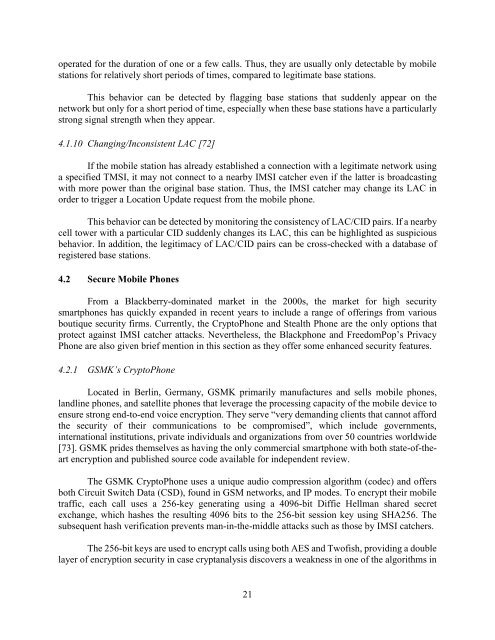IMSI Catchers and Mobile Security
EAS499Honors-IMSICatchersandMobileSecurity-V18F-1
EAS499Honors-IMSICatchersandMobileSecurity-V18F-1
Create successful ePaper yourself
Turn your PDF publications into a flip-book with our unique Google optimized e-Paper software.
operated for the duration of one or a few calls. Thus, they are usually only detectable by mobile<br />
stations for relatively short periods of times, compared to legitimate base stations.<br />
This behavior can be detected by flagging base stations that suddenly appear on the<br />
network but only for a short period of time, especially when these base stations have a particularly<br />
strong signal strength when they appear.<br />
4.1.10 Changing/Inconsistent LAC [72]<br />
If the mobile station has already established a connection with a legitimate network using<br />
a specified TMSI, it may not connect to a nearby <strong>IMSI</strong> catcher even if the latter is broadcasting<br />
with more power than the original base station. Thus, the <strong>IMSI</strong> catcher may change its LAC in<br />
order to trigger a Location Update request from the mobile phone.<br />
This behavior can be detected by monitoring the consistency of LAC/CID pairs. If a nearby<br />
cell tower with a particular CID suddenly changes its LAC, this can be highlighted as suspicious<br />
behavior. In addition, the legitimacy of LAC/CID pairs can be cross-checked with a database of<br />
registered base stations.<br />
4.2 Secure <strong>Mobile</strong> Phones<br />
From a Blackberry-dominated market in the 2000s, the market for high security<br />
smartphones has quickly exp<strong>and</strong>ed in recent years to include a range of offerings from various<br />
boutique security firms. Currently, the CryptoPhone <strong>and</strong> Stealth Phone are the only options that<br />
protect against <strong>IMSI</strong> catcher attacks. Nevertheless, the Blackphone <strong>and</strong> FreedomPop’s Privacy<br />
Phone are also given brief mention in this section as they offer some enhanced security features.<br />
4.2.1 GSMK’s CryptoPhone<br />
Located in Berlin, Germany, GSMK primarily manufactures <strong>and</strong> sells mobile phones,<br />
l<strong>and</strong>line phones, <strong>and</strong> satellite phones that leverage the processing capacity of the mobile device to<br />
ensure strong end-to-end voice encryption. They serve “very dem<strong>and</strong>ing clients that cannot afford<br />
the security of their communications to be compromised”, which include governments,<br />
international institutions, private individuals <strong>and</strong> organizations from over 50 countries worldwide<br />
[73]. GSMK prides themselves as having the only commercial smartphone with both state-of-theart<br />
encryption <strong>and</strong> published source code available for independent review.<br />
The GSMK CryptoPhone uses a unique audio compression algorithm (codec) <strong>and</strong> offers<br />
both Circuit Switch Data (CSD), found in GSM networks, <strong>and</strong> IP modes. To encrypt their mobile<br />
traffic, each call uses a 256-key generating using a 4096-bit Diffie Hellman shared secret<br />
exchange, which hashes the resulting 4096 bits to the 256-bit session key using SHA256. The<br />
subsequent hash verification prevents man-in-the-middle attacks such as those by <strong>IMSI</strong> catchers.<br />
The 256-bit keys are used to encrypt calls using both AES <strong>and</strong> Twofish, providing a double<br />
layer of encryption security in case cryptanalysis discovers a weakness in one of the algorithms in<br />
21



